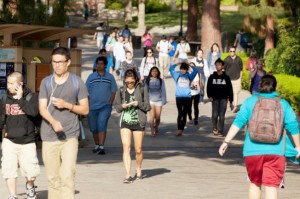5.6 Million Youths Out of School, Out of Work
 •
•
Allie Bidwell, Reporter
Speaking with Savion Castro now, you wouldn’t know he was ever off track in his academic career.
The 20-year-old sophomore at the University of Wisconsin—Madison is double majoring in economics and sociology, worked on President Barack Obama’s 2012 re-election campaign and last year helped found a group called “I M Power,” an organization that provides civic education and encourages students to vote.
But Castro could have been one of the 5.6 million young Americans known as disconnected youth – those neither in school nor working. When his mother, a single parent, suffered a back injury and the family moved in with an aunt in Madison, Castro felt the need to take care of her and became truant as early as second grade. The trend continued throughout his middle school years.
“We were moving around a lot and I was worried about her health,” Castro says. “It messed up my priorities because of course you’re going to put the health of your family above whatever else. I didn’t value school as much back then.”
In their annual Opportunity Index, the national campaign Opportunity Nation and Measure of America found that high school graduation rates are up, more adults are going to college and unemployment has dropped drastically since 2011. But poverty rates across the board are essentially unchanged since 2011, and nearly 1 in 7 people between the ages of 16 and 24 are considered disconnected youth, in limbo between school and work.
“When young adults are neither connected to education or employment – they’re really disconnected from institutions – communities don’t do well,” says Mark Edwards, founder and co-director of Opportunity Nation, a national campaign focused on expanding economic mobility in America.
Although Castro made a course correction – in part through Wisconsin-Madison’s PEOPLE (Pre-College Enrichment Opportunity Program for Learning Excellence) Program, which helps promising youths from low-income and underrepresented communities get ready for college – far too many young people are struggling, Edwards says.
One of the biggest impacts on educational outcomes is the stagnant poverty rate in the United States, which has remained essentially unchanged at 15.9 percent since 2011. What’s difficult to reconcile, however, is the fact that while poverty rates nationwide have flat-lined during the last several years, the unemployment rate has dropped 30 percent.
“That speaks to the kinds of jobs that are being created right now,” Edwards says. “It’s going to only benefit all of us if we make sure even those who simply don’t have the resources can get access to quality education. When that happens, we’ll all do better.”
The five states with the lowest overall education opportunity scores in the index – Nevada, Mississippi, West Virginia, Louisiana and New Mexico – also have overall poverty rates above the national average. Mississippi’s, for example, is 24.2 percent. The education score factors in preschool enrollment rates, on-time high school graduation rates and college attainment rates.
In fact, the same states that have above-average poverty rates also have lower on-time high school graduation rates, fewer adults with a post-secondary education, lower preschool enrollments, lower rates of Internet access and higher youth disconnection rates.
“What we know is the long-term impacts of not just children but families living in poverty are quite significant,” Edwards says. “We have to keep our eye on that ball.”
In communities where partnerships between educational institutions, employers and local governments exist, there appear to be better outcomes in terms of overall education opportunity, youth disconnection and opportunity in general, Edwards says.
For Castro, being able to connect with students with similar backgrounds through the PEOPLE program and learn from college students helped him realize school should be a priority, and better prepare him for college .
“One of the biggest things is the social capital that such a diverse group of kids builds,” Castro says of the PEOPLE program. “You get perspectives from different sets of experiences, and a different outlook on life – a more holistic outlook.”
Aside from being more academically prepared to enter college – from learning how to write a college-level paper, to understanding he couldn’t rely exclusively on a calculator for math – Castro says he gained outside knowledge that has helped him along the way. Upon entering the university last year, he already had friends on campus, knew how to communicate with professors and could navigate his way around campus – social adjustments that can often overwhelm new students.
“When you’re alone, you think the world is against you,” Castro says. “But when you have kids going through similar things, you band together and find a way to work it out.”








